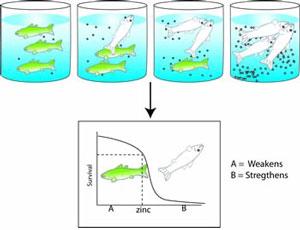Stressor-Response Relationships from Laboratory Studies
Concept
Stressor-Response Relationships from Laboratory Studies: At the impaired site, the cause must be at levels associated with related biological effects in laboratory studies.
 Figure 4-2. Stressor-Response Relationships from Laboratory Studies.
Figure 4-2. Stressor-Response Relationships from Laboratory Studies.
Click to view more informationLaboratory test results (test endpoints) are best analyzed as stressor-response relationships rather than as statistical thresholds such as No Observed Effects Concentrations (NOECs). Laboratory findings and stressor-response relationships from the case should be compared both in terms of the magnitude and the duration of exposure. Extrapolating responses of test organisms in the lab to the observed biological effect in the case usually is required. Species sensitivity distributions can be used to summarize single species test data for comparison to impairments observed in the field.
Examples
Consider elevated concentrations of aqueous zinc as a candidate cause of reduced benthic macroinvertebrate abundance. What findings support or weaken the case for increased zinc as a cause, based on stressor-response relationships from laboratory studies?
- Supporting evidence - Laboratory toxicity tests show that Daphnia have an acute LC50 of 2.3 mg/L for zinc, and zinc concentrations at the impaired site are 2.0 - 3.8 mg/L.
- Weakening evidence - Laboratory toxicity tests show that Daphnia have an acute LC50 of 2.3 mg/L for zinc, but zinc concentrations at the impaired site are 0.01 mg/L.
How Do I Analyze the Data?
Randomized, replicated, controlled laboratory tests are valuable experimental tools because they allow researchers to control for the variability and potential confounding factors normally encountered under field conditions. These laboratory studies may test chemicals, materials, or media from other sites with contamination similar to that from the case. Relationships can be estimated using indicators of internal exposure (e.g., body burdens), but more commonly use measures of external exposure (e.g., aqueous concentrations).
Results of multiple laboratory tests, using different species, durations, life stages or conditions, may be analyzed and extrapolated in various ways. This can result in the availability of multiple pieces of evidence that are relevant to this type of evidence. In such situations, the individual pieces of evidence may be evaluated and scored, and then an overall score for Stressor-Response Relationships for Laboratory Studies should be selected based on the preponderance of the evidence.
The comparison of laboratory test results and observations from the case may be comparisons of point values (e.g., an LC50 versus the concentration measured after a fish kill), a distribution versus a point value (e.g., a chronic concentration-response model for Daphnia reproduction versus the concentration measured a an impaired location) or a distribution versus a distribution (e.g., a species sensitivity distribution versus a concentration-response model for benthic arthropod abundance in the case).
What Evidence Would Support or Weaken the Case for a Candidate Cause?
- Data showing that exposure of laboratory organisms to stressor levels observed at the impaired site results in decreased survival, growth or reproduction
- Data showing that exposure of laboratory organisms to stressor levels observed at the impaired site does not result in decreased survival, growth or reproduction
How Do I Score the Evidence?
| Finding | Interpretation | Score |
|---|---|---|
| The observed relationship between exposure and effects in the case agrees quantitatively with stressor-response relationships in controlled laboratory experiments. | This finding strongly supports the case for the candidate cause, but is not convincing because the correspondence could be coincidental due to confounding or differences in organisms or conditions between the case and the laboratory. | ++ |
| The observed relationship between exposure and effects in the case agrees qualitatively with stressor-response relationships in controlled laboratory experiments. | This finding somewhat supports the case for the candidate cause, but is not strongly supportive because the correspondence is only qualitative, and the degree of correspondence could be coincidental due to confounding or differences in organisms or conditions between the case and the laboratory. | + |
| The agreement between the observed relationship between exposure and effects in the case and stressor-response relationships in controlled laboratory experiments is ambiguous. | This finding neither supports nor weakens the case for the candidate cause. | 0 |
| The observed relationship between exposure and effects in the case does not agree with stressor-response relationships in controlled laboratory experiments. | This finding somewhat weakens the case for the candidate cause, but is not strongly weakening because there may be differences in organisms or conditions between the case and the laboratory. | - |
| The observed relationship between exposure and effects in the case does not even qualitatively agree with stressor-response relationships in controlled laboratory experiments, or the quantitative differences are very large. | This finding strongly weakens the case for the candidate cause, but is not convincing because there may be substantial and consistent differences in organisms or conditions between the case and the laboratory. | -- |
Helpful Tips
- Data showing that stressor levels at an impaired site cause adverse effects in laboratory studies do not prove that that agent is the most influential stressor at the impaired location. Laboratory-based evidence is made stronger when it also is supported by Stressor-Response Relationships from Other Field Studies.
- Note that it is not possible to refute the case for a candidate cause using stressor-response relationships derived from laboratory studies.
